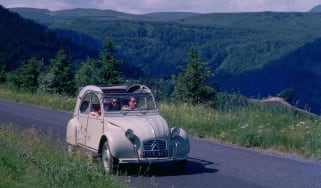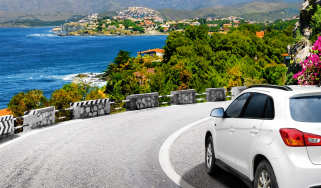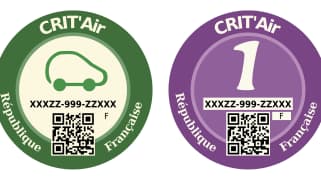Driving on the autobahn: speed limits, driving tips and history
The German autobahn is world-famous for its de-restricted high-speed zones. Here’s everything you need to know about driving on the autobahn...
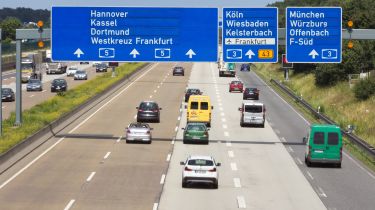
If you’re driving in Germany it probably won’t be too long before you encounter a stretch of autobahn. The autobahn is the German motorway network, managed by the central government in a similar way as motorways in other countries, and is usually the fastest way of covering longer distances by car.
Of course, the autobahn isn’t just like motorways in other countries, it’s renowned for its unrestricted zones where there is effectively no speed limit for certain classes of vehicle. Video clips and stories of cars accelerating to speeds in excess of 200mph on the autobahn have made the roads famous outside of Germany in a way that no other country’s motorways are.
The most important thing to note here is that if high-speed motoring is your worst nightmare and the idea of driving on the autobahn is causing you a certain level of nervousness, there’s really nothing to worry about. The German autobahn certainly isn’t a drag strip free-for-all and there are rules in place to ensure everyone uses the road safely, which are strictly policed. Many sections of the autobahn make use of speed limits and regulations that are fairly similar to those on British motorways and driving conditions are very similar most of the time.
German driving licences are among the most difficult and expensive driving certifications to obtain in the world. This helps to set the standards expected of motorists in the country at a very high level. Driving on the autobahn might be a daunting prospect for those unfamiliar with it, but anyone used to driving on UK roads may well be pleasantly surprised by the general standard of driving they encounter. You will see vehicles travelling at high speed in unrestricted autobahn sections but as a general rule, the good standards of observation and lane-discipline maintained by German motorists makes it all feel far safer than you would imagine.
If you’re interested in finding out more about driving on the autobahn, we have compiled this guide with all the information you need...
Is there really no speed limit on the autobahn?
Although you may have heard that there are no speed limits on the German autobahn, this is not entirely true. Approximately half of the autobahn network is unrestricted and has no limit on speed for cars. Car drivers are free to travel at whatever speed they like on these sections, which are indicated by a white sign with four black lines diagonally across it. Although no blanket speed limit exists, there is an advisory limit of 130kmph (81mph) as well as fixed limits on certain classes of vehicles.
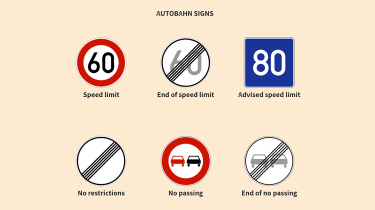
Permanent speed limits are also enforced on around a third of the autobahn network, you’ll see a white circular sign with a red outer ring indicating the speed limit when there is one in place.
The remaining sections of the autobahn make use of variable or conditional speed limits and these are communicated by digital overhead screens like those on smart motorways in the UK. These variable speed limits are usually put in place as a result of bad weather causing poor driving conditions, road accidents or to help manage traffic congestion
German Autobahn speed limits
|
Speed limit |
Vehicle class |
|
60kmph (37mph) |
Buses carrying standing passengers and motorcycles pulling trailers |
|
80kmph (50mph) |
Vehicles with maximum allowed weight exceeding 3.5t (except passenger cars) passenger cars and trucks with trailers, and buses |
|
100kmph (62mph) |
Passenger cars pulling trailers certified for 100kmph and buses certified for 100kmph not towing trailers |
|
130kmph (81mph) |
Advisory speed limit for other vehicles |
What is the fastest speed ever on the autobahn?
There’s no shortage of video footage on the internet showcasing the frightening speeds drivers push their vehicles to on the autobahn. Cars reaching speeds of over 100mph is a common occurrence on these roads, but some drivers of high-performance cars have been known to target the elusive figure of 300km/h (186 mph) for bragging rights. Some go even further.
The fastest speed ever officially recorded on the autobahn was set by famed German racing driver Rudolf Caracciola in 1938 when he reached 432.7 km/h (268 mph) in the Mercedes-Benz W125 Rekordwagen on a closed section.
Can anyone drive on the autobahn?
Your eligibility to drive on the autobahn will differ slightly depending on the country your driver’s licence is from, though the following criteria provide a general rule-of-thumb for those looking to drive on German roads including the autobahn:
- You must have a full, valid driving licence from your country of residence.
- You must carry your licence with you at all times while driving.
- You must not have been disqualified from driving.
- You must comply with all restrictions and German legislation (such as wearing corrective eyewear when driving).
- You must have reached the minimum age of driving in Germany, which is 18 years old.
For further details about using the roads overseas, check out our full guide on driving abroad.
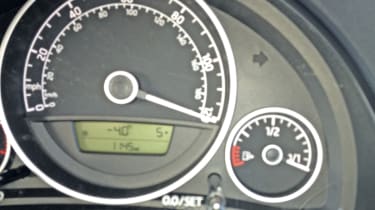
Is the autobahn safe?
Driver safety on the autobahn has been a subject of debate and controversy for many years. Proponents of the autobahn have championed the German motorway network for its efficiency and unmatched safety record, while some research has suggested that more incidents occur on the autobahn than on other European road networks as a result of its high-speed unrestricted zones.
Research by the European Transport Safety Council (ETSC) in 2019 suggested that the German autobahn network was the 10th safest in Europe with a risk of death around twice as high as on motorways in the UK. The German Road Safety Council also did a study that indicated around 25% more deaths occurred on unrestricted sections of autobahn than on sections with speed limits.
If you are concerned about driving on the autobahn, it’s important to remember that the autobahn is a road and not a racetrack. Drivers looking to push their cars to the limits would be better off visiting a private racetrack such as the Nurburgring instead.
For most drivers in Germany, the autobahn is considered nothing more than a purpose-built road network for travelling between point A and point B, and it should be used as such. If you are planning a journey using the autobahn, you can do your bit to maintain safety by respecting other drivers, concentrating on the road and adhering to the rules. It also pays to be aware that you could encounter cars travelling at very high speeds on de-restricted sections and drive accordingly.
Top tips and rules for driving on the autobahn
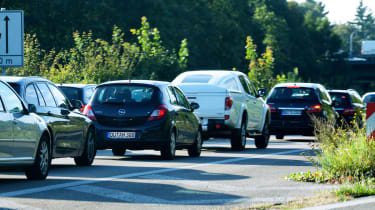
As is the case when driving on any public road, adhering to the rules and regulations will help limit the chance of any collisions or incidents taking place. Given the high speeds cars travel at on the German autobahn, drivers must comply with the following rules and advice to keep the road safe:
1. Remain in the right lane whenever possible
The Germans enforce a similar system to that which you’ll find on a British motorway, where drivers must remain in the inside lane unless overtaking - although they obviously drive on the other side of the road. Use the right lane whenever possible when driving on the autobahn.
2. Always overtake on the left
Overtaking on the left is an essential rule that allows the autobahn to function safely. If you need to overtake a vehicle you should always use the lane to its left, even if you’re stuck behind a slow middle-lane hogger. It’s also important to return to the right-hand lane after completing an overtake regardless of the speed you’re driving at, as someone could be quickly approaching from behind at an even greater speed.
3. Mirror, signal, manoeuvre
It is vital to pay close attention to your mirrors before moving out of your lane for an overtake. Remember, cars could be travelling at speeds way north of 100mph in the lanes to your left, so you must be completely aware of any approaching vehicles when using the autobahn, even if they appear to be a long way behind you.
After checking your mirrors, use your indicators as early as possible to alert other drivers of your intentions. Constantly check for fast-approaching vehicles and move back into the right lane once you have completed your manoeuvre.
4. Obey the speed limits
Contrary to popular belief, there are in fact speed limits in place on around 30% of the autobahn network, while conditional speed limits are imposed on an additional 20% depending on weather and driving conditions. Speed limits are enforced on the roads surrounding built-up areas such as cities and other popular destinations, so keep an eye out for speed limit signs located on the side of the roads or digital overhead update boards. If you are towing a caravan or driving a motorhome that weighs over 3.5 tonnes you will be restricted to an 80kmph (50mph) limit.
5. Take regular breaks
Maintaining a high level of focus and concentration is imperative to staying safe on any road. Just as on UK motorways, long drives on the autobahn can be draining, so it is recommended that you stop and take a break every 2 hours. You’ll find the German equivalent of our service stations positioned at regular intervals on the autobahn where you can stop and refresh yourself.
6. Make way for emergency vehicles
Emergency vehicles often use the autobahn to get around quickly, so keep an eye out for blue flashing lights in your rear-view mirror. If an emergency vehicle pulls up behind you, pull over to the nearest side of the road - either left or right depending on which lane you are positioned in - and if you’re in traffic form a ‘Rettungsgasse’: a clear lane for emergency vehicles to pass through.
7. Other rules of the autobahn
The German law states that you need to keep a warning triangle and a first aid kit in your car at all times in case of a breakdown. You should never stop or park anywhere on the autobahn, and you should avoid getting out of your car when stuck in a traffic jam. Also, make sure your car is filled with fuel and ready to drive by checking tyre pressures and any essential fluids before setting off.
History of the autobahn
The idea for a national German motorway system first came about in the mid-1920s, though a lack of funding and political support meant little progress was made until the 1930s. The rise of the Nazi party in 1933 resulted in a major construction effort of the autobahn network as a result of Adolf Hitler’s admiration for the concept. By 1936, around 400,000 workers were involved in the manufacturing of materials and construction of the autobahn itself, attracting global media coverage and attention.
Despite Hitler’s enthusiasm for the project, the progress of autobahn construction was slow and tailed off dramatically during World War II, as a result of petrol shortages and the Nazi party’s preference for railways. While the majority of the German workforce were deployed in the military or for wartime production, construction of the autobahn was continued by forced labourers and concentration camp inmates, albeit at a slower pace as a result of the conditions the workers were subjected to.
The autobahn became increasingly disused throughout World War II and many existing sections were converted into temporary airstrips. By the end of World War II, only 2,400 miles of autobahn surfacing were completed out of a targeted 12,000 miles and much of what was completed had been damaged as a result of Allied bombing.
Following the war, the progress of the autobahn’s construction began to take off in West Germany. The West German government invested in the repair of damaged sections and continued development of the road network, giving rise to the autobahn as we know it today. Autobahn sections in Eastern Germany were relatively neglected in comparison with those in the West until the reunification of Germany in 1990, following which the final sections were completed and renovated to finalise the construction of the autobahn project.
Today, the German government maintains the autobahns with a dedicated workforce of engineers, construction workers and a specialised police force to keep the network in operation year round. Videos of drivers reaching speeds in excess of 200mph are plentiful across social media, and have helped develop the reputation of the roads and the attraction with tourists. The autobahn network helps millions of German residents and tourists travel across the country quickly and efficiently, showcasing German engineering at it’s very best.
Now read our article on how to drive the Nurburgring… virtually
Find a car with the experts



